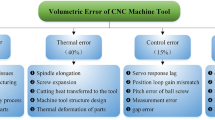Abstract
The aim of the work reported here was to utilize Taguchi methods to optimize surface finish and hole diameter accuracy in the dry drilling of Al 2024 alloy. The parameters of hole quality are analyzed under varying cutting speeds (30, 45, and 60 m/min), feed rates (0.15, 0.20, and 0.25 mm/rev), depths of drilling (15 and 25 mm), and different drilling tools (uncoated and TiN- and TiAlN-coated) with a 118° point angle. This study included dry drilling with HSS twist drills. The settings of the drilling parameters were determined by using Taguchi’s experimental design method. Orthogonal arrays of Taguchi, the signal-to-noise (S/N) ratio, the analysis of variance (ANOVA), and regression analyses are employed to find the optimal levels and to analyze the effect of the drilling parameters on surface finish and hole diameter accuracy values. Confirmation tests with the optimal levels of machining parameters are carried out in order to illustrate the effectiveness of the Taguchi optimization method. The validity of Taguchi’s approach to process optimization is well established.
Similar content being viewed by others
References
Kelly JF, Cotterell MG (2002) Minimal lubrication machining of aluminium alloys. J Mater Process Technol 120:327–334
Nouari M, List G, Girot F, Coupard D (2003) Experimental analysis and optimisation of tool wear in dry machining of aluminium alloys. Wear 255:1359–1368
Chen WC, Tsao CC (1999) Cutting performance of different coated twist drills. J Mater Process Technol 88:203–207
Zhao H (1994) Predictive models for forces, power and hole oversize in drilling operations. PhD thesis, University of Melbourne, Australia
Dasch JM, Ang CC, Wong CA, Cheng YT, Weiner AM, Lev LC (2006) A comparison of five categories of carbon-based tool coatings for dry drilling of aluminum. Surf Coat Technol 200:2970–2977
Basile SA (1993) Modeling transverse motions of a drill bit for process understanding. Precis Eng 15:258–265
Roger MS, Russell VL (1998) Experimental design for process settings in aircraft manufacturing. In: Statistical case studies: a collaboration between academe and industry. Society for Industrial and Applied Mathematics (SIAM), pp 235–247
Pirtini M, Lazoglu I (2005) Forces and hole quality in drilling. Int J Mach Tools Manuf 45:1271–1281
Furness RJ, Wu CL, Ulsoy AG (1996) Statistical analysis of the effects of feed, speed, and wear on hole quality in drilling. J Manuf Sci Eng 118:367–375
Kalidas S, DeVor RE, Kapoor SG (2001) Experimental investigation of the effect of drill coatings on hole quality under dry and wet drilling conditions. Surf Coat Technol 148:117–128
Nouari M, List G, Girot F, Gehin D (2005) Effect of machining parameters and coating on wear mechanisms in dry drilling of aluminium alloys. Int J Mach Tools Manuf 45:1436 –1442
Haan DM, Batzer SA, Olson WW, Sutherland JW (1997) An experimental study of cutting fluid effects in drilling. J Mater Process Technol 71:305–313
Bono M, Ni J (2001) The effects of thermal distortions on the diameter and cylindricity of dry drilled holes. Int J Mach Tools Manuf 41:2261–2270
Agapiou JS (1993) Design characteristics of new types of drill and evaluation of their performance drilling cast iron. I. Drill with four major cutting edges. Int J Mach Tools Manuf 33:321–341
Yang WH, Tarng YS (1998) Design optimization of cutting parameters for turning operations based on the Taguchi method. J Mater Process Technol 84:122–129
Taguchi G (1990) Introduction to quality engineering. Asian Productivity Organization, Tokyo
Ross PJ (1996) Taguchi techniques for quality engineering. McGraw-Hill International Editions, Singapore
Bagci E, Aykut Ş (2006) A study of Taguchi optimization method for identifying optimum surface roughness in CNC face milling of cobalt-based alloy (stellite 6). Int J Adv Manuf Technol 29:940–947
Tsao CC, Hocheng H (2004) Taguchi analysis of delamination associated with various drill bits in drilling of composite material. Int J Mach Tools Manuf 44:1085–1090
Lou MS, Chen JC, Li CM (1998) Surface roughness prediction technique for CNC end-milling. J Ind Technol 15:1–6
Yang JL, Chen JC (2001) A systematic approach for identifying optimum surface roughness performance in end-milling operations. J Ind Technol 17:1–8
Phadke MS (1989) Quality engineering using robust design. Prentice-Hill, Englewood Cliffs, NJ
Minitab User Manual Release 13.2 (2001) Making data analysis easier. MINITAB Inc., State College, PA
Lindman HR (1992) Analysis of variance in experimental design. Springer-Verlag, New York
Author information
Authors and Affiliations
Corresponding author
Rights and permissions
About this article
Cite this article
Kurt, M., Bagci, E. & Kaynak, Y. Application of Taguchi methods in the optimization of cutting parameters for surface finish and hole diameter accuracy in dry drilling processes. Int J Adv Manuf Technol 40, 458–469 (2009). https://doi.org/10.1007/s00170-007-1368-2
Received:
Accepted:
Published:
Issue Date:
DOI: https://doi.org/10.1007/s00170-007-1368-2




